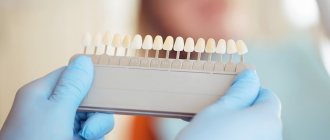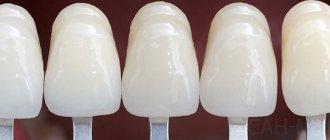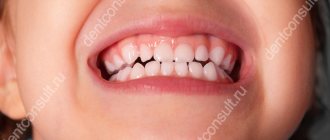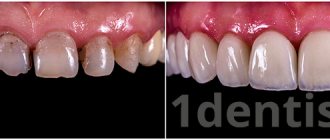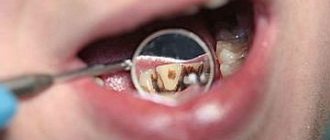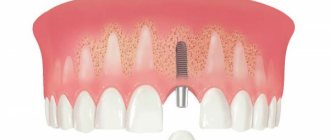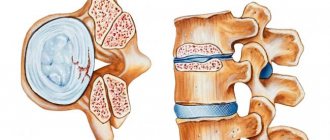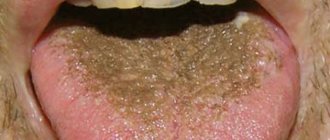The color of tooth enamel is individual for everyone, even white has various shades, which must be taken into account when making prosthetics or installing a filling. To determine the natural tone as accurately as possible, dentists use the Vita scale. This is a special standard designed to select the tone of materials in accordance with the natural color of tooth enamel.
The Vitascale scale is a special standard, made in the form of a compact palette with fixed samples made of cardboard or plastic. It is used to compare the results obtained during the whitening procedure, making crowns, veneers, and to select the shade of the filling.
Indications for installing a dental bridge
Dental bridge, bridge-like prosthesis are the names of a design for permanent wear for the purpose of functional replacement of lost dental units.
They are installed in the absence of 1-4 teeth located in a row. A classic of the genre is a bridge consisting of three crowns, the most popular among patients. Gaps in the dentition cause several problems at once. This includes disruption of the digestive tract, accelerated loss (resorption) of bone, and deformation of the jaw, changing the oval of the face.
All of these issues are resolved with the help of dentures, and in particular, bridges. The patient is offered several options for prosthetics, each of which has its own advantages and disadvantages. The financial issue is of no small importance, since the price of high-quality structures is quite high.
Important! Most clients of dental clinics are concerned about the aesthetic factor, which also largely depends on the material and type of the future bridge.
Installation of dental bridges is possible in the absence of both chewing teeth and front incisors. They fully restore both the appearance of lost teeth and their functionality.
You should know that for prosthetic bridge construction, abutment teeth are required. If there are no teeth, or they are quite badly damaged, then removable dentures or dentures on implants can replace the bridge.
Implants previously implanted in the jaw are fitted with a removable or conditionally removable structure. This approach is a good solution if the patient does not want to grind his teeth for a bridge.
Price issue
When choosing between different materials, it is important to consider their cost. The question of how much a porcelain crown costs concerns many. The price of prostheses made from this material starts from 10 thousand rubles and reaches 20-30 thousand per unit including installation. Also take into account the costs associated with preparing for prosthetics - treatment of the abutment tooth, as a rule, always has to be paid separately.
Author: Chernov A. R. (Thank you for your help in writing the article and the information provided)
Dental bridge: what it looks like and how it works
Dental bridges are non-removable prosthetics, which means you cannot remove them yourself, without the help of a doctor. Dentures are fixed on the supporting teeth, replacing missing units in the middle part.
The main parts of the design are artificial teeth - more precisely, their crown parts - and retainers, through which the dental bridge is securely attached to the oral cavity.
Fixing bridge fastenings can be represented directly by dental crowns placed on the supporting teeth, inlays and clasps - iron brackets. In some cases, the design is supplemented with an element that imitates gum tissue.
For reference: A dental bridge received its name for its visual resemblance to a building structure.
The bridge can “sit” on the prosthetic bed in different ways and connect to the gums with varying degrees of density. There are 3 types of connections:
- lavage (temporal). There remains a slight gap between the dental bridge and the gums, which is not noticeable, but makes cleaning much easier. In addition, food debris does not get stuck under the denture;
- tangent. The prosthesis touches the gums, as if passing along one tangent line. This type of dental bridge is relevant in the smile area, since it does not interfere with normal conversation, can be cleaned with a toothbrush and looks good in appearance;
- saddle-shaped The bridge fits very tightly to the gums.
For reference: The saddle-shaped type of prosthesis, which sags in the middle, still causes a lot of controversy among dentists. B. Bynin in the middle of the last century considered its use advisable only in removable bridge structures due to the risk of the formation of bedsores on the mucous membrane.
Recently, in connection with the massive introduction of metal-ceramics, supporters of the use of saddle-shaped bridges in metal-ceramic dentures have appeared.
In any case, the type of dental bridge is selected by the doctor providing orthopedic treatment, with the active participation of the patient.
Types of dental bridges
Dental bridges are classified according to material and production technology. The starting materials for bridges can be:
- metal;
- metal ceramics;
- ceramics;
- zirconium dioxide;
- polymers.
Depending on the manufacturing technology, dental bridges are classified into the following types:
- adhesive, which are used mainly for prosthetics of 1 dental unit. This type of bridge has a frame made of fiberglass arch with a crown located on it. The adhesive structure is placed on halves or even quarters of crowns and fixed to the supporting teeth with special glue;
- classic, when the supporting units are completely covered with crowns.
Important! Adhesive technology for fixing bridges allows you to preserve your natural teeth as much as possible.
Metal bridges, in turn, are divided into cast and stamped. The former are preferable, as they are more durable and can withstand extreme loads, have a long service life and delicate shapes.
Material and technology are factors that determine the price and quality of dental bridges. However, in recent years, implant-supported dentures have become increasingly popular. And patients (not without reason) begin to doubt that a dental bridge is the only right solution.
Content
- 1 Essay
- 2 Classification 2.1 Classification by microstructure
- 2.2 Classification by processing technology
- 2.3 Classification of crystalline ceramics
- 4.1 Shooting
- 7.1 Denture
Bridge VS implant
It should be noted that among all possible options for fixed prosthetics, dental bridges undoubtedly occupy a leading position. But now the choice has become wider, and doctors definitely offer installation of implants for consideration.
Let us say right away that if prosthetics is possible without implantation, then the latter cannot do without the manufacture of prostheses. The implant is implanted into the bone tissue and is essentially an iron rod protruding from the gum. Therefore, a crown, dental bridge or removable denture must be placed on it.
There are very few disadvantages of implants, and they can only be called disadvantages conditionally. First of all, this is the high price of treatment, since it includes the installation of implants and the production of prostheses.
For reference: In the process of prosthetics according to the “implant + dental bridge” scheme, at least two doctors are involved - an implant surgeon and an orthopedist.
Another disadvantage of prosthetics on implants is the duration of treatment, if you do not take into account simultaneous or one-stage implantation. Classic surgery most often involves a bone graft or sinus lift, after which a break of several months is required. Only after osseointegration of the bone tissue is completed is it possible to install a dental bridge and other types of prostheses.
Pros of implantation:
- the integrity of the supporting teeth, since they do not need to be ground;
- reliability of fixation of titanium dental roots due to the strong “rooting” of the implant in the oral cavity;
- the comfort of using the bridge is comparable to using your own teeth;
- durability of prostheses, service life has no restrictions.
It is worth noting that implantation treatment has contraindications, although very few. However, if they are present, you will have to return to installing a dental bridge in the classical way or choose removable prosthetics.
New classification of ceramic materials in dentistry: how to make the right choice?
Ceramics in the dental industry began to gain popularity in the 18th century due to its superior aesthetic characteristics compared to other materials. Parisian pharmacist Alexis Duchateau literally opened up the prospects of ceramics in dentistry by making one-piece teeth from porcelain and ceramic masses as part of a prosthesis. Later, in 1903, Charles Land contributed to the further introduction of ceramics into the dental industry by proposing the manufacture of onlays and inlays, as well as single-piece crowns. All this led to the spread of a new type of restoration - jacket crowns lined with ceramics.
Since then, ceramics as a dental material has gone through several stages of development, changing in terms of chemical composition and in terms of improving aesthetic properties. There were also some modifications in the processes of its manufacture and storage. Due to continuous development, the indications for the use of ceramic materials have also undergone some changes and expanded significantly. The highly aesthetic properties and biocompatibility of ceramics became its advanced characteristics even among the first representatives of this group of materials, but their weak tensile and shear strength dictated the need to develop ceramic materials with greater wear resistance and a guarantee of their long-term functioning, especially in cases of manufacturing restorations with a thicker layer of veneer or when the fixation of the structure involved, to a large extent, connection only with dentin with a minimal amount of residual enamel.
The development of advanced CAD/CAM technologies, as well as the use of modern press materials and new casting approaches, have made it possible to produce more durable, and at the same time minimally invasive structures with excellent aesthetic characteristics. This contributed to the development of an optimal metal-free ceramic material adapted to specific treatment conditions, since new representatives of dental ceramics are much more stable than their predecessors, much easier to use, and more universal.
However, the choice of the appropriate ceramic material depends on the clinical situation and the technique of its use. Unfortunately, a huge amount of conflicting information regarding the indications for the use of different ceramic materials confuses doctors as to which material is best to choose for a particular design in a specific clinical case. Understanding the principles of classification, knowledge of the composition and characteristics of different ceramic materials will help dentists and technicians not only not to be confused in choosing a material, but to be absolutely sure of the correctness of their decision.
Composition, characteristics and classification
Ceramics are an inorganic, non-metallic solid produced by heating its components at high temperatures and then cooling them. The composition of ceramics includes nitrides, carbides, metal oxides, borides, as well as various combinations and mixtures of these components. Thus, a material called ceramic is not actually ceramic by definition unless it is created using some other processing method or has additional organic components in its composition.
Ceramic materials have a crystalline or partially crystalline structure, but can also be amorphous (for example, like glass). Since most dental ceramic materials contain at least several crystalline components, some authors define ceramics as an inorganic crystal-containing substance, that is, excluding non-crystalline glass by this definition, which, however, is essentially ceramics in its production .
Dental ceramic materials are generally classified by their microstructure, which facilitates scientific understanding of their composition and chemical nature, but in truth this does little to assist dentists or technicians in selecting the appropriate material for a particular clinical situation. The method of processing ceramics significantly affects its mechanical properties and, therefore, the possibility of using the material in different clinical cases. Thus, only by comprehensively classifying dental ceramic materials, both on the basis of their composition and according to the methods of their production and processing, can conditions be provided for assessing the clinical parameters of their use in each specific situation. The classification presented below is based on one principle: the use of ceramic masses for different designs - from the most conservative/least invasive (with maximum preservation of the natural tooth structure) - to the least conservative/most invasive (with minimal preservation of tooth tissue). This categorization of materials also takes into account the previously published classification, which mentioned both glass ceramics and several completely new and innovative materials that have just entered the market.
CL-I (powder/liquid)
Class I (CL-I) includes powdered and liquid types of ceramic materials consisting of silica particles immersed in a glassy matrix with a varying amount of crystalline phase in this matrix (for example, Creation Porcelain, Jensen Dental; Ceramco 3, DENTSPLY International; EX-3, Kuraray Noritake Dental, Inc.). The CL-I group also includes representatives of feldspathic ceramics, so called because they were originally made from feldspar (an aluminosilicate containing some potassium, sodium, barium or calcium). Several variants of feldspathic ceramic materials are still available on the market today (for example, VITA VM 13, VITA Zahnfabrik; Vintage Halo, Shofu) (photo 1-3).
Photo 1. View before preparation (clinical case of making a veneer from feldspathic ceramics - material group CL-I)
Photo 2. View after preparation (clinical case of making a veneer from feldspathic ceramics - material group CL-I)
Photo 3. View after fixation of the structure (clinical case of making a veneer from feldspathic ceramics - material group CL-I)
Materials of the CL-I group are made by hand (photo 4) and belong to the group of materials used in the most conservative designs. They are generally the most transparent ceramic materials, but also the most fragile. Given their degree of translucency, they are the ideal choice for restorations of crowns with a sufficiently large amount of residual enamel and relatively well-preserved tooth structure (≥50% of the enamel volume retained, or when the area of fixation is at least 50% enamel, or when 70% of marginal margins are enamel, but not dentin). Enamel-bonded feldspathic ceramic restorations have proven their success and durability in many clinical studies. Representatives of this group of materials demonstrate not only high aesthetic performance, but also excellent performance characteristics, are quite convenient for use as a thin layer applied directly to the enamel structure, and are also considered optimal for non-metallic structures. CL-I materials require a layer thickness of 0.2-0.3 mm to provide the desired shade of the restoration.
This class of materials is typically used for restorations of anterior teeth, but can also be used in some cases for restorations on premolars and, in rare cases, on molars. The risk of their fracture is quite low with adequate functional load (photo 5-6).
Photo 4. Manual application of feldspathic ceramics.
Photo 5. View before preparation: the need to correct the aesthetic appearance of the anterior teeth (clinical case of making a veneer from feldspathic ceramics - material of group CL-I)
Photo 6. View after fixation of the structures (clinical case of making a veneer from feldspathic ceramics - material of group CL-I)
CL-II (glass ceramics)
The composition of CL-II ceramic materials is similar to the analogues of the CL-I group in that both have a glassy matrix, however, in their glass-crystalline structure and types of crystals, these two classes of materials still differ. In CL-II materials, crystalline constituents can either be added to the glass composition or grown in a glassy matrix. CL-II ceramics also differ from CL-I ceramics in the manufacturing process, as the former is supplied in the form of dense industrial blocks for pressing and milling. Taking into account the characteristics of crystal types and the possibilities of clinical use, materials of the CL-II group can be divided into two subgroups: CL-IIa and CL-IIb.
CL-IIa
Materials in this subgroup contain low to medium (<50%) amounts of leucite-feldspathic glass. Materials (e.g. IPS Empress CAD, Ivoclar Vivadent; Authentic, Jenson Dental; VITABLOCS Mark II, VITA Zahnfabrik) consisting of less than 50% crystalline substance are more glass-like and therefore require a bonding procedure when fixing them.
Like all CL-II materials, CL-IIa materials can be used for the same indications as CL-I analogues: for restorations in the area of anterior teeth, premolars, and, in rare cases, molars. In addition, they have proven their long-term clinical results even under higher functional loads, as well as in cases of exposed areas of dentin that are in direct contact with the ceramic during cementation. They can be quite transparent, but usually require a thicker layer during use to recreate the desired level of esthetics and appropriate tooth shade (minimum working thickness of 0.8 mm if the material is covered with veneering ceramic) (photo 7-8).
Photo 7. Veneers made from materials of group CL-IIa with a minimum thickness of the material layer in the area of the incisal edge.
Photo 8. View after fixation of veneers made from CL-IIa material (Sam Lee, CDT, MDC).
Materials in this subcategory also demonstrate increased strength, primarily due to the technique of their production in the form of dense blocks, as well as the ability of leucite to change the coefficient of its own thermal expansion, thereby preventing the propagation of cracks. These dense glass- and leucite-containing materials are suitable for the manufacture of more voluminous veneers, crowns in the frontal area and inlays and onlays in the posterior teeth, provided that a strong connection and fixation of the structures with the underlying tissues is ensured.
CL-IIb
This subgroup of new materials with a medium to high (i.e. > 50%) content of crystalline glass or glass ceramics, in their microstructure consists of a glass matrix that surrounds a second phase represented by individual crystals. At the beginning of production, the materials consist of homogeneous glass, but the formation of secondary centers of formation and growth of crystals ensures an improvement in the mechanical and physical properties of representatives of this group due to the presence of the maximum number of crystalline units around which areas of compressive stress are formed.
An example of these materials is lithium disilicate (eg IPS e.max, Ivoclar Vivadent) - a glass-ceramic material consisting of silica, lithium dioxide, aluminum oxide, potassium oxide and phosphorus pentoxide. Once the crystalline component of the material has reached an optimal level of growth during its production, the material is ground into powder and processed using various techniques and approaches. Indications for the use of lithium disilicate are similar to those for other glass-ceramic materials, but it can also be used for the manufacture of solid crowns. If the latter are cemented with composite cement, lithium silicate structures will ensure effective functioning of full crowns even in cases of high loads in the molar area (photo 9-11).
Photo 9. View before preparation (Steve Lee, CDT, MDC).
Photo 10. View after preparation (Steve Lee, CDT, MDC).
Photo 11. Fixation of crowns made from materials of group CL-IIb (Steve Lee, CDT, MDC).
A new material in this category is zirconium-strengthened lithium disilicate (ZLS) (for example, VITA Suprinity, VITA Zahnfabrik (photo 12); CELTRA Duo, DENTSPLY). ZLS materials consist of lithium silicate glass ceramics reinforced with 10% zirconium dioxide crystals. Although these materials are relatively new to the market, initial testing has demonstrated excellent optical and physical performance, similar to the original lithium disilicate materials. The real advantage of lithium disilicates is the sufficient amount of clinical data confirming the long-term and successful results of their use as single restorations in any location.
Photo 12. Optical characteristics of lithium silicate CL-IIb materials reinforced with zirconium.
Restorations made from these materials demonstrate high strength, fracture resistance and excellent esthetics that mimic natural tissue, and are therefore versatile in use for a wide range of clinical indications. They are also recommended for use in critical conditions of crown restoration, when the amount of residual enamel is less than half of its initial volume, or when less than 50% of the bonded tooth surface is represented by enamel, or 30% or more of the marginal tissue is dentin.
Considering the properties of the materials, the use of an adhesive protocol is recommended. However, it should be noted that bonding to dentin is not predictable due to the natural flexibility of dentin, while the rigidity of enamel may provide a more reliable prognosis for the restoration.
CL-III (high strength crystalline materials)
CL-III materials are high-strength crystalline ceramics with minimal or no crystalline phase content, which are manufactured through a sequence of industrial processes. They differ from glass or glass-ceramics in the type of bond formation between the sintered crystalline matrix (which constitutes from 85% to 100% of the volume) and the particles of the crystalline phase.
CL-IIIa
CL-IIIa group of materials are manufactured by creating a porous matrix, formed into a block shape, and finally contoured to the desired dimensions using CAD / CAM technology. After this, the matrix structure is filled with the second molten phase of the material. Lanthanum aluminosilicate glass in liquid or molten form flows into all pores of the matrix due to capillary interaction, creating a dense and reliable material. The final product is 85% crystal mesh intertwined with a small amount of glass. Currently, these materials are disappearing from the market, and they are being replaced by completely 100% polycrystalline ceramics.
CL-IIIb
Subgroup CL-IIIb materials are high-strength 100% crystalline ceramic materials that were originally made on the basis of aluminum oxide (for example, Procera, Nobel Biocare). Recently, they have begun to be manufactured on the basis of zirconium dioxide (for example, LAVA, 3M ESPE; Prettau, Zirkonzahn). Aluminum-based structures have proven themselves well for the manufacture of single crowns, but in the area of molars, due to the increased risk of chipping, preference should be given to materials based on zirconium or lithium disilicate. Crowns made on the basis of zirconium can also be used in cases of extensive loss of tooth tissue, an increased risk of elastic deformations and stress stresses, in the manufacture of single crowns in the molar area or as part of bridges (photo 13 and photo 14), as well as in conditions with problematic implementation of high-quality bonding (for example, in the subgingival area).
Photo 13. Zirconium crowns (CL-IIIb), lined with ceramics. Imitation of gums using pink ceramics (Aram Torosian, MDC).
Photo 14. View of the structure after fixation in the oral cavity (Aram Torosian, MDC).
In cases where it is difficult to ensure high-quality implementation of the adhesive fixation protocol (moisture control problems, high parameters of shear forces and tensile stresses at the tooth/restoration interfaces), it is recommended to use ceramic materials of group CL-III or metal-ceramics (CL-IV), since the structures , made from these materials, can be recorded using conventional direct protocols. When using all-zirconia crowns, however, attention should be paid to the relationship with the opposing teeth, since problems most often arise from inadequate contact with the teeth of the opposite jaw.
Whether it is alumina or zirconium oxide, both materials exhibit higher strength than CL-I and CL-II materials and can be used as an alternative to metal for the core substructure. However, due to their increased opacity (caused by the high content of crystalline substances), they alone cannot provide an optimal level of aesthetic profile. They are covered with other ceramic materials, and thus obtain both a durable structure and excellent aesthetics. Group CL-III ceramics require a layer thickness of 1.2 mm to 1.5 mm, depending on the desired substructure color. More translucent representatives of these materials are currently used for the manufacture of all-zirconia restorations in the posterior teeth. The first on the market from this category was BruxZir ((Glidewell Laboratories), but in the current period there are no limits to the choice, and new representatives of these ceramic materials continue to replenish the dental materials market (photo 15 and photo 16).
Photo 15. View of the zirconium blank (CL-IIIb) before color correction and final sintering (Enrico Steger/Zirkonzahn).
Photo 16. View of the structure after sintering and achieving the desired shade (CL-IIIb) (Enrico Steger/Zirkonzahn).
CL-IV (cermet)
Materials of group CL-IV are, in fact, analogues of materials of group CL-I fused with a high-strength metal substrate, which allows their use in clinical situations in which the risk of high stresses or deformations increases. They are ideal for situations where the tooth structure is either completely missing or the amount of residual tissue is minimal. Like materials of the CL-III group, metal ceramics are characterized by high strength, but limited aesthetic characteristics. To achieve acceptable aesthetics, the required layer thickness is at least 1.5 mm. Although similar to CL-III zirconium oxide materials, their coefficient of thermal expansion is still significantly different due to the nature of the metal framework. The aesthetic properties of metal ceramics can be improved by using high-quality cladding materials (for example, Captek, Argen USA Inc.) (photo 17).
Photo 17. Restoration of two molars with all-ceramic crowns from materials of the CL-IV group.
conclusions
Knowing the indications for the use of ceramic materials of different classes, as well as understanding the difference in their structural composition, will help make the right choice, regardless of the conditions of each specific clinical case. It should be taken into account that, in addition to the criteria mentioned above, the choice of material for the structure is also influenced by the amount of preserved tooth tissue, the possibility of high-quality bonding, aesthetic criteria, the shape of the smile and the shade of the future restoration.
Materials of groups CL-I and CL-II have excellent aesthetic characteristics, but are not strong enough. And although all types of ceramic materials are more resistant to compression loads than to tension and shear deformation, if the risk of excessive loads is minimal, and aesthetics require the best, weaker, but more optically suitable materials from the first two groups can be used. Representatives of the CL-III and CL-IV groups, on the contrary, have increased strength, but lose in aesthetics. If the level of functional stress is high, and more durable materials (for example, zirconia, alumina, or metal) are unavoidable, then veneering ceramics can be used to achieve an optimal aesthetic profile. The ideal, of course, is to manufacture a structure from one class of materials, but the availability of different types makes it possible to manufacture restorations that meet both functional strength criteria and aesthetic requirements.
Authors: Edward A. McLaren, DDS, MDC Johan Figueira, DDS
Dental bridges made of polymers
This is another type of dental bridge from a low price category. At first glance, they may seem very attractive, even visually, and you won’t have to pay much for dentures.
However, plastic dental bridges have even more disadvantages than metal ones. The only advantage is the price.
Disadvantages of plastic dental bridges:
- poor aesthetics - artificial teeth do not have the transparency and pearlescent luster characteristic of natural teeth;
- susceptibility to chips, cracks and other damage beyond repair. A broken part will have to be replaced with a new one, which certainly does not reduce the cost of dental prosthetics;
- hyperallergenicity;
- short service life of a dental bridge - over time, the plastic darkens or turns yellow under the influence of the alkaline environment of the oral cavity and quickly wears out.
For reference: The average lifespan of plastic dental bridges is 4 years. After this period, new artificial teeth need to be installed.
It is advisable to install a denture made of polymer material as a temporary structure when a permanent bridge is in the process of production. It is especially in demand when the front teeth are lost, since in this case the gaps cause not only physical, but also moral inconvenience.
Care rules for long-term use of dentures
In order for porcelain structures to serve you for a long time, it is important to treat them with care. By taking the following precautions, you will extend their life:
- Clean your mouth thoroughly after each meal - use an irrigator, rinse,
- do not use dental floss or brushes in the area of the installed crown - it can be damaged,
- Once every six months, carry out hygienic cleaning in the dentist’s chair: caries does not threaten the artificial tooth. However, the resulting plaque can penetrate under the gingival margin and destroy the root system of a living tooth,
- give preference to foods that are not very hard or particularly tough: also avoid eating too hot or too cold food and drinks at the same time (such temperature changes can negatively affect not only the enamel of living teeth, but also any artificial material),
- Give up bad habits: don’t snack on floss with restored (as well as natural) teeth, don’t open lids, don’t bite your nails.
Metal-ceramic dental bridges – selection criteria
A metal-ceramic dental bridge combines the best qualities of metal and ceramics, while eliminating their disadvantages - low aesthetics and strength. The beauty of this type of denture is due to the fact that the metal base is lined with a layer of special dental porcelain called ceramics. It is thanks to its application layer by layer that a shade of artificial teeth close to natural is achieved.
The minimum service life of a metal-ceramic dental bridge is 7 years, and throughout the entire period it retains its shape and color. However, it also has a number of contraindications for which prosthetics are not performed:
- pronounced deviations in bite;
- bruxism – grinding teeth during sleep;
- metal allergy;
- severe forms of periodontal inflammatory processes – periodontitis and periodontal disease;
- severe destruction of supporting teeth;
- low dental crowns at the supporting units.
Despite the almost impeccable aesthetics of the material, metal-ceramic dental bridges are not recommended to be placed in the smile area, since the dark frame can show through the ceramic layer. In the area of the anterior teeth, it is preferable to install metal-free dentures that have the best aesthetic properties.
Important! The supporting units for a metal-ceramic dental bridge can be either your own or implanted dental roots.
Porcelain: material features
Today, porcelain, first used in prosthetics just over two centuries ago, is considered the most popular material. Crowns made from it are essentially a ceramic product without metal impurities in the composition. The product is produced by processing ceramic mass at high temperatures. The complexity of the manufacturing process of porcelain structures determines their high qualities - wear resistance, precision fit, high aesthetics. They are easy to install, hypoallergenic, and serve their owner for many years, maintaining their original color and shape.
This is interesting! It is believed that the first dentures with a porcelain component appeared about three centuries ago. Orthodontist Pierre Fauchard sharpened crowns from durable ivory, additionally strengthening them with a layer of gold. To make the structure look aesthetically pleasing, he made the top covering from a thin layer of ceramic to match the adjacent units. It was only towards the end of the 19th century that the technology of firing a porcelain crown on platinum foil appeared.
It is important to understand that porcelain and ceramics are actually the same thing. Porcelain is a type of ceramic, one of its highest quality types, since it has a snow-white color even from the inside, i.e. in cross-section, as well as high strength characteristics. But in dentistry there is no division as such into “porcelain” and “ceramics”, so crowns are generally called ceramic, even though there are varieties (pressed ceramics, regular or even with the addition of a composite).
Ceramic dental bridges
Ceramic dental bridges are an ideal solution for dental prosthetics in the smile area. Dental porcelain, which is a ceramic material, allows light to pass through, resulting in the translucent effect of natural tooth enamel.
Therefore, ceramic dentures have an appearance that is as close to natural as possible, and sometimes it is difficult to distinguish them from your own teeth even at close range. This type of bridge has excellent aesthetics, but is inferior in strength to another type of ceramic - zirconium dioxide.
Dental bridges from zirconium began to be made relatively recently, and they have not yet found widespread use. But this is only a matter of time, since this material is superior to ceramics in strength and is not inferior to it in aesthetics. Plus, it's as durable as metal.
Zirconium dental prostheses have such high mechanical strength that they can be used to make a dental bridge even for 6 units missing in the oral cavity! And the durability of such bridges is evidenced by an average service life of 17 years.
Advantages and disadvantages of the material
It is no coincidence that Europeans call special dental porcelain an enamel substitute. Prostheses made from it not only perfectly replicate the anatomical features and shade of the original units, but they are also smooth, translucent, and have a mirror-like shine. Exactly like enamel. Porcelain teeth, if they are truly made with high quality, cannot be distinguished from natural ones. Therefore, the material is often chosen for prosthetics of the front teeth - those that are located and clearly visible in the “smile zone”.
Complex on 4 OSSTEM implants with delayed loading - from RUB 170,000.
Complex implantation Osstem (South Korea) with delayed loading after 4-6 months.
Guarantee for the doctor’s work - unlimited Call now or order a call
Opening hours: 24 hours a day - seven days a week
In addition, they are quite durable and resistant to chips, and perfectly retain their original shade even when exposed to coloring pigments from food. With proper installation and high-quality oral care (regular hygiene, professional cleanings, avoiding combining hot and cold foods), porcelain products will delight you with their shine, stable shade and shape for about 10-15 years.
And if you have long dreamed of a flawless smile, then porcelain crowns are a great way to achieve it. Installation is quick, the designs are well suited for allergy sufferers who may react to polymers or metal. Products made from pressed ceramics are very light, and you get used to them quickly.
However, this modern aesthetic material has its drawbacks. Due to its fragility, the material does not allow the manufacture of bridge structures. Only single restorations are made from it. And the production of porcelain dentures itself is expensive, which affects the final cost of the product. Especially if the choice fell on modern pressed ceramics.
Interesting! The very first known dentures, as archaeologists testify, were allegedly made from the teeth of wolves and other wild animals. The artifacts were found in Mexico and date back to 2500 BC. Later, dentures were made from the shells of sea creatures and were fixed in the mouth with gold rings. Until the middle of the 18th century, dentures were made from ivory and the teeth of various animals.
CAD/CAM Innovation
The price of dental bridges made of pressed ceramics and zirconium depends significantly on the production technology. Today, CAD/CAM technology, which translates to “computer modeling/manufacturing on a robotic milling machine,” is increasingly becoming the choice of doctors and patients.
The innovative CAD/CAM bridge manufacturing technique involves the use of a 3D scanner, software to create a three-dimensional model of the patient’s entire dentofacial apparatus, and a milling machine on which an orthopedic model of future teeth is created.
This technology practically does not require human participation and allows you to avoid many errors and errors in the execution of the prosthesis. At the end, the dental bridge has an ideal anatomical match with the patient’s specified parameters (direction, inclination of teeth, etc.), which ensures maximum wearing comfort and durability.
Thus, the advantages of ceramic dental bridges are:
- hypoallergenic - both porcelain and zirconium almost never cause allergies, because the materials have a significant similarity in structure to real teeth;
- impeccable aesthetics of the bridge;
- bending stability and maintaining the original shape throughout the entire service life;
- slight tendency to accumulate food plaque in the bridge;
- low maintenance requirements.
Classification
Ceramics can be classified according to the following criteria:[3][5]
Feldspar porcelain fabricated on a dental model, then clinically bonded to the central anterior teeth
Classification by microstructure
At the microstructural level, ceramics can be determined by the nature of its composition and the ratio of amorphous and crystalline components. Infinite variations in the microstructure of materials are possible, but they can be broken down into four main compositional categories with several subgroups:
- Composition category 1 - glass-based systems (mainly silica), an example is feldspathic porcelain.
- Composition Category 2 - glass based systems (mainly silica) with fillers, usually crystalline (usually leucite or, more recently, lithium disilicate)
- Composition category 3 - crystalline systems with glass fillers (mainly alumina)
- Composition category 4 - solid polycrystalline (alumina and zirconium).
Dental ceramics are generally considered biologically inert. However, there may be other toxic effects from depleted uranium as well as some other supporting materials; Additionally, the restoration may increase wear on the opposing teeth.[6]
Classification by processing technology
- Powder/liquid glass based systems
- Processable or pressable units of glass-based systems
- CAD/CAM or stamped suspension, mainly crystalline systems[7]
Classification of crystalline ceramics
Classification of crystalline ceramics[5]
| Manufacturing technique | Crystalline phase | |
| Metal ceramics | Sintering | Leucite |
| Thermal pressing of metal | Leucite, leucite and fluorapatite | |
| All-ceramics | Sintering | Leucite |
| Heat pressing | Leucite, lithium disilicate | |
| Dry pressing and sintering | Alumina | |
| Slip casting and glass infiltration | Alumina, Spinel, Alumina-Zirconium Dioxide (12Ce-TZP) | |
| Soft processing and glass infiltration | Alumina, Alumina-Zirconium Dioxide (12Ce-TZP) | |
| Soft processing and sintering | Alumina, zirconia (3Y-TZP) | |
| Soft processing, sintering and thermal pressing | Zirconium/fluorapatite-leucite glass ceramics | |
| Hard handling | Sanidine, leucite | |
| Hard processing and heat treatment | Lithium disilicate |
Adhesive dental bridges – what are they and when are they placed?
Adhesive dental bridges are also called Maryland or Manhattan bridges and are distinguished by their gentle installation, which does not require grinding or depulping the supporting teeth.
Instead of supporting teeth, a crossbar or fastener with wings is used here to secure the bridge to the teeth in the oral cavity. Dentures of this type are used only to restore the front incisors; they are too fragile for chewing units and simply will not withstand the load.
The advantages of adhesive dental bridges are:
- speed of dental prosthetics - you can close a defect in the oral cavity in just one visit;
- a gentle installation technique, for which there is no need to turn healthy supporting units into pulpless and ground ones;
- ease of care and the possibility of repair in the event of a dental bridge failure;
- affordable price, which is lower than that of ceramic and metal-ceramic bridges.
Disadvantages of orthopedic treatment using adhesive dental bridges:
- susceptibility to mechanical damage and breakdowns, low strength of bridges;
- short service life of no more than 3 years;
- accelerated loss of bone tissue due to lack of load, since the prosthesis is located above the gum;
- the danger of carious damage to the supporting teeth due to the fact that part of the load of the missing tooth is transferred to them, making access for cleaning in places of attachment difficult.
Thus, the review of the main types of dental bridges has been completed; the choice of a specific option for dental prosthetics should be entrusted to the doctor. Perhaps he will offer several methods of orthopedic treatment and will definitely explain all the nuances of installing a bridge.
Installation of dental bridges - the main stages of prosthetics
Orthopedic treatment using dental bridges always begins with an examination and assessment of the patient’s oral cavity. This is perhaps the most important stage for determining the further prosthetic treatment plan.
At stage 1, possible contraindications are excluded, and the most advantageous prosthesis from a functional point of view is selected, which will solve the problem of missing teeth as effectively as possible.
It is mandatory to take a panoramic photograph of the oral cavity, and if necessary, laboratory blood tests are prescribed. After drawing up a treatment plan, the preliminary (zero) stage ends, and work begins on preparing the teeth for prosthetics.
Prosthetics with a classic dental bridge includes several stages:
- To extend the life of a dental bridge, it is necessary to carry out sanitation of the oral cavity: treat caries, remove dental plaque and, if necessary, stop the inflammatory process of periodontal tissue.
- From the “general” they move on to the “specific” – the treatment of supporting teeth. If they are “live”, then the nerve is removed, after which preparation is carried out - in other words, turning. Tooth enamel is ground down in a circle for the best connection with the crowns of the dental bridge. Removal of the nerve is called depulpation and is done to prevent the development of pulpitis due to overheating of the pulp during grinding.
- After grinding the teeth, an impression is made and sent to the laboratory to the prosthetic technician. If the gums are severely injured during the grinding process, then taking an impression of the teeth to make a bridge is postponed to the next visit, after the tissue has healed.
- The dental bridge is ready, fitting is carried out and, if necessary, adjustment is carried out. If the prosthesis fits perfectly, without changing the bite or interfering in the oral cavity, it is “set” on cement.
The installation of a dental bridge is completed with a consultation on caring for the oral cavity in general and the prosthesis in particular.
Dentistry for those who love to smile
+7
Make an appointment
Possible complications after installing a dental bridge
There can be complications after the installation of dental bridges, and there are many types of different errors both in treatment and in the care of the prosthesis. Most often, inflammatory processes develop at the locations of bridges - stomatitis and gingivitis.
The cause of inflammation is, as a rule, improper grinding of the teeth, when the doctor did not make a special ledge - a step on which the lower edge of the bridge crown is placed. The crown should not hang over the root or press into the gum.
The inflammatory process can also develop due to an overly massive intermediate part of the dental bridge, which puts a lot of pressure on the mucous membranes and causes cutting pain, redness and swelling near the denture.
Another reason is that there is not enough space between the dental bridge and the gum, called “flushing space.” A gap that is too narrow will cause food debris to accumulate and become lodged under the denture, causing inflammation and bad breath.
In addition, the sharp edges of dental bridges can rub the tongue, cheeks and gums, causing chronic trauma.
After fixing a dental bridge, the teeth on which it rests may become sore. There is usually only one reason – lack of timely treatment. Unnoticed caries in time can lead to inflammation and the development of pulpitis and periodontitis. Ultimately, the tooth may even be lost.
One of the causes of periodontitis may be a dental bridge that is too long or a crown that is too high, which causes overload of the tissues surrounding the tooth.
Caution: Galvanic Syndrome
It is worth mentioning separately about the so-called galvanic syndrome - the body’s reaction to the presence of metal prostheses in the mouth. These can be not only dental bridges, but also individual crowns, orthodontic appliances, inlays and even fillings with amalgam.
When interacting with saliva, which acts as an electrolyte, a potential difference occurs in the metal with the formation of galvanic currents. This complication manifests itself as a metallic taste in the mouth, dryness, burning, headaches, and sleep disturbances. The dentures themselves may darken.
The development of galvanism requires the resumption of orthopedic treatment with the replacement of a dental bridge made of a more inert metal or dental porcelain.
Important! Factors of increased risk of galvanism are initial defects in dentures, mechanical damage during operation of bridges, changes in the acid-base environment in the mouth to the acidic side due to stomatitis, periodontitis and gastrointestinal pathologies.
After installing dental bridges, other unpleasant consequences are possible. The most important and difficult stage of treatment is the preliminary stage, when planning and choosing the type of dental bridge takes place.
Complications can be caused by:
- incompletely studied data on the patient’s health in general and the oral cavity in particular;
- incorrect interpretation of x-rays;
- insufficient x-ray studies;
- inattentive approach to customer complaints and wishes.
The listed shortcomings of the doctor are a serious mistake and often lead to serious complications after orthopedic treatment with the installation of dental bridges.
What to do if the dental bridge begins to wobble
If you suddenly feel that your dental bridge is unstable, you should immediately consult a doctor. Perhaps one or both teeth on which the prosthesis rests have broken, or the bridge has been insufficiently fixed with a cementing compound.
The cause of a loose dental bridge is inflammation caused by caries, if the prosthesis is installed on living teeth, on teeth with canals that have been filled for a long time or poorly.
It will not be possible to cope with the situation on your own, and it will not be possible to correct the situation without removing the prosthesis. Diagnostics and x-rays are necessary to assess the condition of the teeth on which the dental bridge stands.
Attention! It is strictly forbidden to fix the prosthesis yourself using household adhesives or any compounds. This can lead to severe burns, inflammation and allergic reactions near the bridge.
Porcelain crowns: the process of creation and installation
The process of creating porcelain dentures is quite labor-intensive. It consists of two stages.
Preparatory stage
At this stage, the doctor determines the condition of the tooth that will need to be restored. The specialist also sanitizes the oral cavity and performs therapeutic procedures. Next, the doctor begins to work with the tooth on which a ceramic prosthesis will be installed. It is advisable to remove the nerve from it to protect it from further inflammation under the crown.
If there is nothing left from the top of the tooth, it will not be possible to fix the crown - you must first build up the tooth. For this, pins or stump inlays are used (the first option is universal, the second is individual, laboratory). If the crown remains, then it is given the shape of a cone. Pure ceramics are quite thin, so little living tissue is ground away - a layer of hard tissue will need to be removed from the prepared unit to form a ledge 0.8 to 1.5 mm wide. It is this thickness of the walls of the future porcelain crown that ensures the strength of the product. The prepared apex becomes like a cylinder or a truncated cone.
Next, the orthopedist makes several impressions or impressions of the prosthetic area and the entire jaw. And selects the shade of the future artificial unit. The data obtained will be sent to the dental laboratory, where the prosthetic structure will be manufactured. Take this period up to a couple of weeks. During this period of time, the doctor will install a protective temporary plastic structure on the prepared tooth.
Laboratory stage
The technician, having received all the data from the orthopedist, begins making the crown. First, a model of the patient's jaw is cast based on the impressions. A cap made of platinum foil is placed on a specific tooth, which is filled with porcelain mass. Next, the product is double fired - inside and outside. The final stage is adjusting the size, giving the shape, the desired shade and glazing the resulting artificial tooth, final firing at a very high temperature - just under 1000°C.
On a note! Some ceramic materials (mostly pressed) are processed using CAD/CAM milling technology. That is, first a scan of the oral cavity or a finished model of the jaw is performed, the crown is created in a special program, and then turned on a robotic machine. Of course, this is more expensive for the patient, but it is more accurate, and the result is more predictable.
What to do if a dental bridge falls
The answer is the same as in the previous case - go to the dentist. If the prosthesis was installed very recently, less than a year ago, then the most likely reason is tooth decay under the bridge.
A dental bridge may fall out because its service life has expired, that is, the prosthesis has worn out. In this case, the bridge must be replaced with a new one. To avoid encountering such a problem, it is recommended to regularly check the condition of the teeth and the bridge itself, as well as have professional cleaning and timely treatment of caries, especially on the teeth adjacent to the bridge.
It is important to remember that ground teeth are very vulnerable to bacteria and food plaque, so with poorly performed prosthetics they can easily be destroyed. And then the question of fixing the new dental bridge is called into question. If you are missing several teeth in a row, you will most likely need to get implants.
Pain and swelling of the teeth under the bridge are also reasons to urgently consult a doctor. Rinses and ointments will not help here, and time will be lost. As a result, inflammation will intensify and it will be more difficult to cope with it.
